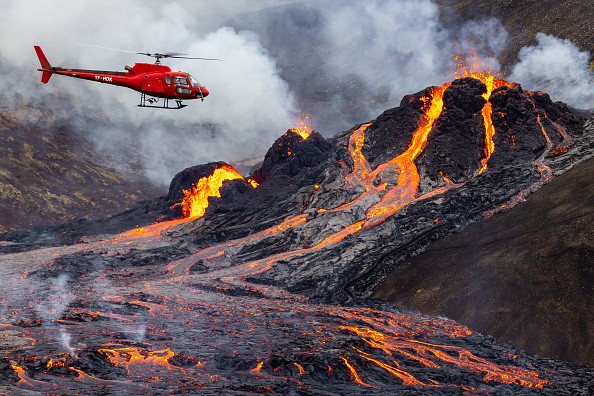The Mountain Fagradals volcano in southwest Iceland had been inactive for 6,000 years. Though on Friday night, with subsequent weeks of earthquakes in the region, the volcano became active. The eruption is the first that has been encountered by the Reykjanes Peninsula where the volcano is located in 781 years.
According to photos of the glow and Associated Press, footage of the eruption reveals the bright lava flowing out of the earth, brightening an otherwise complete dark night. The light from the lava could be noticed up to 20 miles far from Reykjavík, Iceland's capital.

The Eruption Site
Icelandic Police on Friday released a report that the community was to remain indoors and keep their windows shut to avoid gas pollution. According to the United State Environmental Protection Agency, when volcanoes turn active the lava pours many potentially dangerous gases, including hydrogen fluoride, sulfur dioxide, and carbon dioxide.
The Icelandic Meteorological Office explained on Saturday morning that the pollution from this eruption, still, is not anticipated to result in much disturbance for people except close up to the site of the eruption.
The office on its website wrote that no volcanic ash was found but an increased level of volcanic gases has been assessed near the eruption site. Officials and scientists are surveying the emissions closely. A recent video captured from the Coast Guard helicopter - of the eruption at Geld. gardalur valley in Reykjanes peninsula.
The Volcanic Movement
The Icelandic Meteorological Office on Saturday morning reported that volcanic energy since Friday evening had "somewhat reduced." Researchers at the department have not cited key concerns towards the population in the region, as the lava spot is not up to 1 square kilometer. The officials explained lava fountains are little and lava flows are presently a very local threat.
The Scientific Council for Civil Protection disclosed on Saturday morning that they do not think the volcanic eruption is a danger to buildings. "The eruption is minor and the volcanic movement has kind of drop since yesterday night. The eruptive rift is estimated between 500 - 700 meters long. The lava area is less than 1 kilometers. Lava fountains are little and lava spews now is no danger sign locally" Icelandic Meteorological Office tweeted.

A Day Before the Eruption
A screenshot from the seismograph indicated the hours before the eruption.
Since February 24 southwest Iceland has been struck by a surge of thousands of earthquakes. Several of them had a magnitude of 3 or higher, which implies that they could be felt. On Thursday, only one day before the eruption, the International Maritime Organization announced that there had been 400 earthquakes in around seven hours. Despite the extent, it was "somewhat less" seismic movement compared to other mornings where there have been approximately 1,000 earthquakes.
RELATED ARTICLE : Volcanoes Erupt Without Warning Because of New Findings
For more news, updates about volcanic eruptions and similar topics don't forget to follow Nature World News!
© 2025 NatureWorldNews.com All rights reserved. Do not reproduce without permission.





